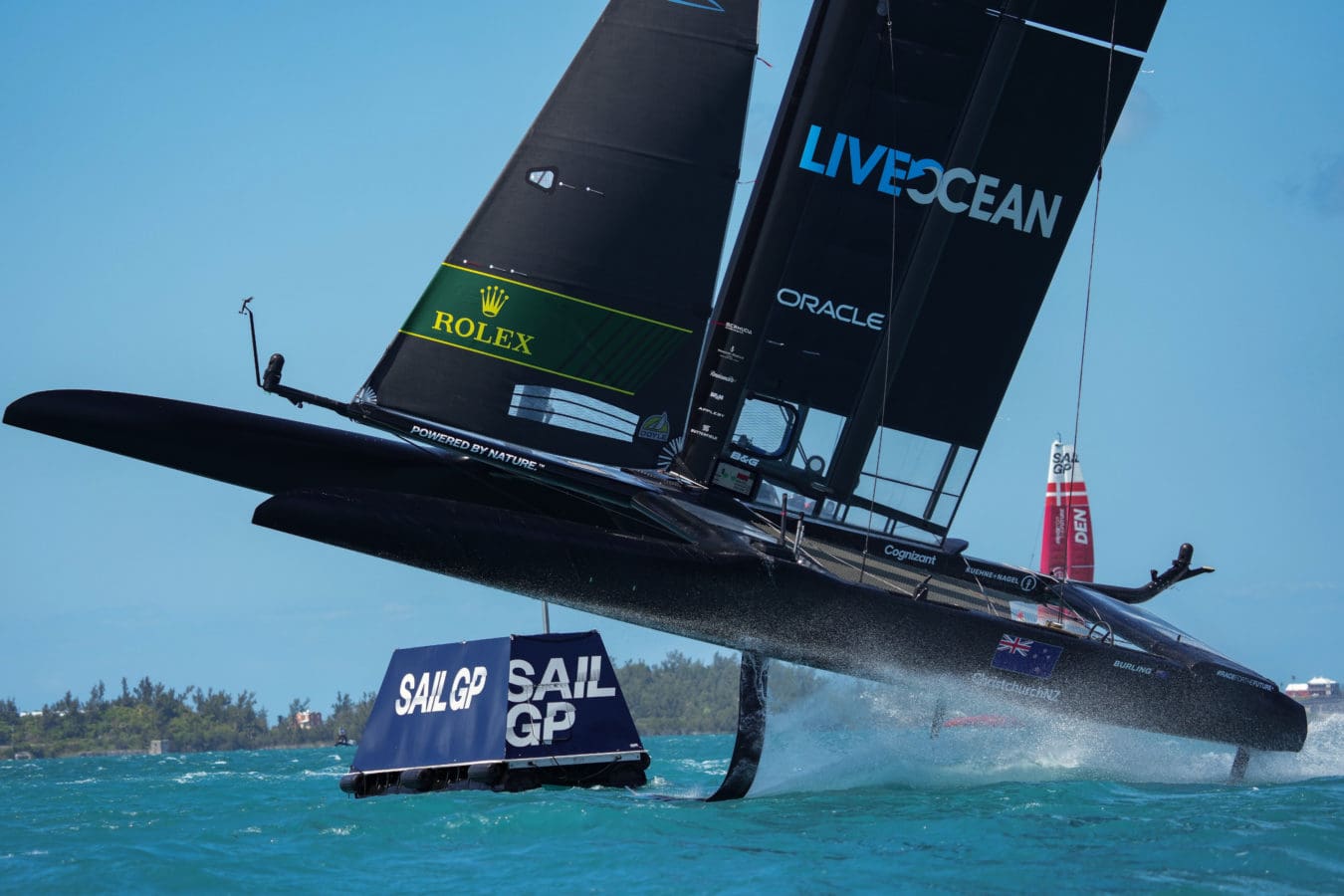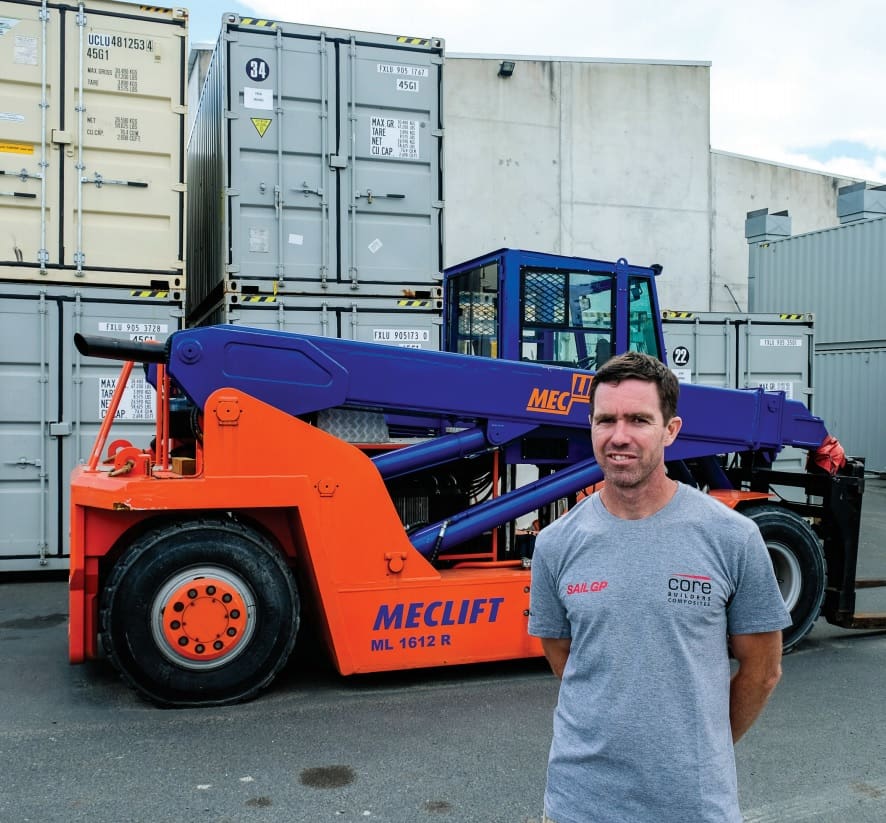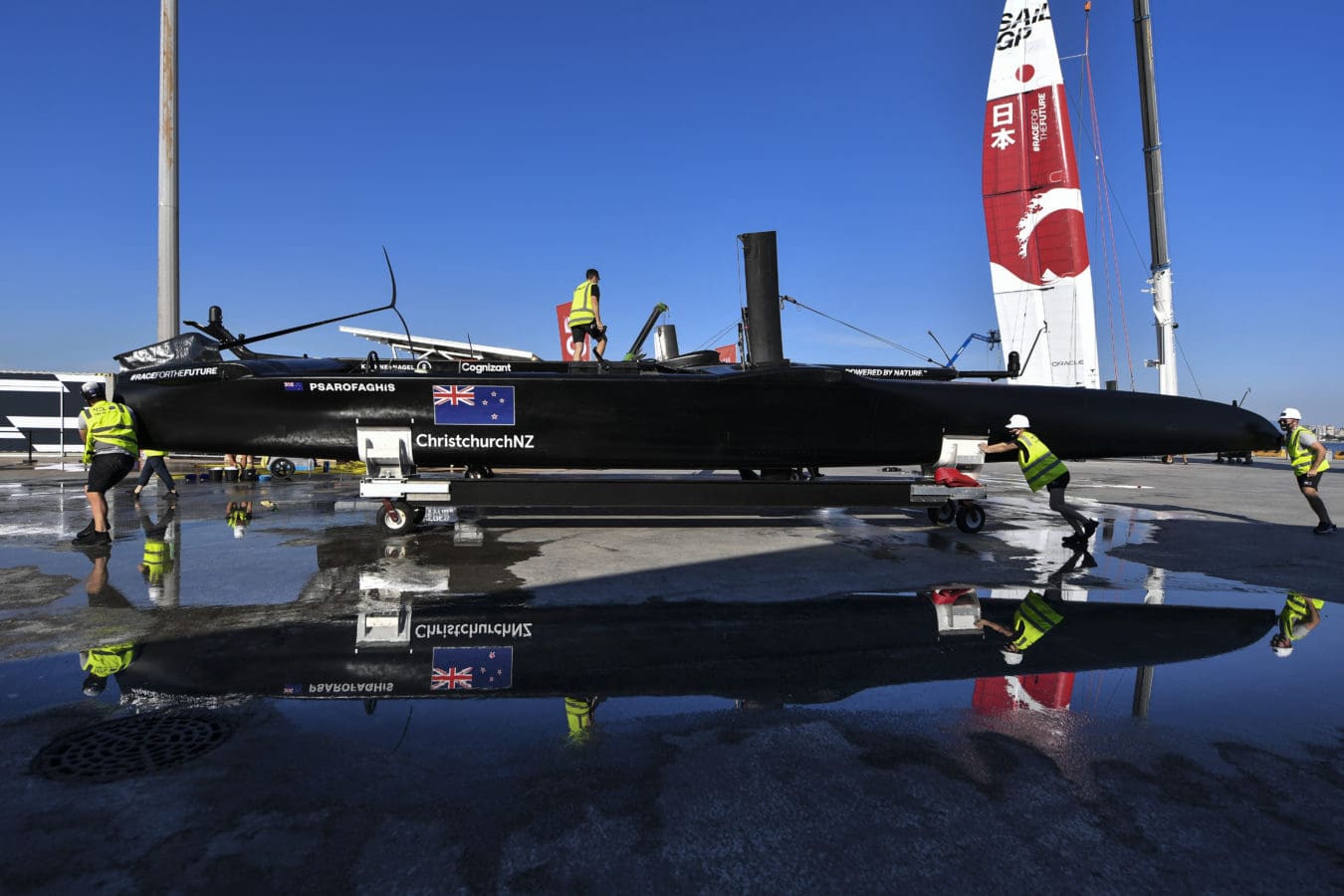RNZYS Breeze Magazine By Ivor Wilkins (republished with permission)
If you are a person who struggles to pack a weekend sailing bag and then still leaves the dock with half the essentials missing, spare a thought for Brad Marsh who has responsibility for the daunting challenge of moving the entire SailGP event from venue to venue around the world under the pressure of immutable time constraints.
With the Bermuda and Italian events of the series just ticked off, the second season of SailGP is under way following severe COVID disruption.
Marsh, who is a graduate of the RNZYS Youth Training Programme, is operations manager for the series. His role involves packing and keeping track of more than 80 shipping containers, juggling with shipping and transport schedules to deliver them on time at venues around the world, setting up a race village, assembling a fleet of complex yachts in time for pro teams to arrive and race, providing pit service to support them with maintenance and repair during intense four-day regattas and then packing it all up and moving to the next stop on the calendar.
While the COVID interruption was a setback, it also allowed pause for thought and to refine the process and the product.

“The past year with Covid has given us an opportunity to go back and data-mine every aspect of the operation to work out what we can optimise around cost, people, resources, operations, parts etc,” says Marsh. “That has been a big part of our analysis.”
With the circuit growing to seven venues and eight teams for 2021 – including a first[1]time New Zealand crew led by Peter Burling and Blair Tuke – the challenge has grown and will continue to grow towards a target of 10 venues.
Marsh, who has worked in sailing and shore related capacities in America’s Cup and Volvo Ocean Race teams, has been in his role with SailGP from its inception in 2018.

His first task was to source and customise 90 40ft shipping containers, each one designed and outfitted to perform specific tasks, from transporting the boats and equipment to housing specialist service teams.
“Having acquired the containers, we set up a production line, moving them from one tent to the next at our Warkworth facility, north of Auckland. Some needed major engineering, with doors, internal divisions, internal insulation, lining, electrical and electronic cabling, air conditioning units, specialist cabinetry, work benches, and so on.”
Meanwhile, inside the Core Builders Composite facility, initially set up for Larry Ellison’s post-2007 Oracle-backed America’s Cup campaigns, the fleet of 50ft hard-wing catamarans from the 2017 Cup regatta in Bermuda was modified and equalised for circuit racing.
“The change from America’s Cup mode to SailGP circuit boats meant a change from something built for a one-off regatta to a circus, where we roll into town, pitch our tents, sail for four days and pack up again. In those short cycles of putting boats together, running them hard and breaking them down again, you inflict the same wear and tear as you would with one month of continuous sailing.
“We have spent past two years upgrading everything to make it more fit for purpose, but we frequently get caught out by scale. An America’s Cup team has scale of one or two boats and a team of 100 people. Now we have a team of less than 100 looking after eight boats. With catamarans, the problem multiplies by at least by two. Replacing something across a fleet of eight means you are often looking at 16 items, or if the boat has four or more of the parts involved, it can be up to 80 items, sometimes into the hundreds.
“Then there are spares. You are looking at large numbers of individual items that you always need to have on hand. On tour, we have to be self-sufficient with everything.”
Every component, including additional new boats, foils and wings, is designed and built in-house at the Warkworth facility. For maintenance alone, in the course of a year, the technical team will replace 1,000 parts.
“The machine shop runs full time in Warkworth. That way we control cost, workflow, quality assurance, development and we retain the intellectual property.”
Once on the road, each stop on the circuit takes just short of four weeks — three weeks for set-up and pack-up bracketing four or five days of sailing.
“We give the infrastructure team a week to get everything set up,” Marsh explains. “That starts with 80 containers arriving on site in a precise formation. They then erect 12 large tents, one for each team, plus additional tents for the wings and technical team. They also erect grandstands, hospitality facilities and a public event village separate from the technical area.
“Then the technical team has a week to assemble the boats and calibrate them for that specific venue. Then we are into sailing, after which we pack it all up again and move on.”
In the first season, the circuit involved shipping from New Zealand to Sydney, then across to California. After the San Francisco regatta, SailGP chartered two trains and sent the whole shebang cross-country to New York for the third event; then by sea to England, with a convoy of trucks moving the equipment to Cowes. For the final event in Marseilles, the containers were split, some going by sea and some by road via the Channel Tunnel.
During racing, the technical team operates as pit crew. “Each team has its own people to get them through daily race operations, but anything technical, or involving damage comes back to the SailGP crew under Marsh’s direction.
“Within the team, we have different specialist departments: hydraulics, electronics, rigging, boat-building, sail-making etc. That is about 60 people. If there is a major incident, like a crash, we flood resources in to make sure everybody is ready to start the next day.
“In Season One, we had capsizes in New York and Cowes, we had wings wiped out in San Francisco and Cowes, we had a couple of serious collisions. But we had a 100% track record of starting racing every day with all the boats in the fleet ready to go.”

That often involves the lights burning late into the night. Racing usually goes into the late afternoon, so by the time all the boats are craned back on shore and checked, it is well into the evening before work actually commences.
“Of course, we do not have a 100% track record of all the boats finishing every day,” Marsh continues. “Our job is to present each team with their boat optimised and ready to race in the morning. What they do after that is on them.
“These are pro teams operating at a very high level. They push the boats to the limit, so it is natural that there are breakages. There are parameters on these boats and you know that if you exceed those parameters, there is going to be damage.”
Keeping a close eye on those parameters is a data team — affectionately referred to as the “geeks and weirdos” — who monitor live data streaming continuously from an array of sensors on each boat and telling a second-by-second story of the loads incurred and every micro input and trim adjustment made by the crew.
If a boat reports an issue, time is of the essence. There are only 13 minutes between each race to fix the problem before the next start sequence.
Take the example of a dagger board not going down. The data team can see that the button has been pushed and the electronic actuator has triggered the message to the ram and the ram has tried to work, so probably the lock failed to disengage. With the problem diagnosed in seconds, the appropriate specialist team is despatched on the water to fix it. They replace the offending part, test it 10 times and jump off.
Alternatively, the data may show that the chain of command never commenced. Maybe the button failed, in which case it is instantly replaced and tested. Maybe, however, it was never properly pushed in the heat of battle. Again, the system is tested 10 times. If it works 10 times, it is operator-error and blushes all round.
“Data is key to everything,” says Marsh. “These boats have an amazing touch point of information analysis coming in all the time. It is instrumental in how the boats are sailed, in how we diagnose problems, and how coaches analyse and debrief sailors. The link in all of that data management is Oracle.”
Being on the road for more than 200 days of the year is demanding, as is the stress of keeping the show on the road. “During a regatta, I do not get much sleep,” Marsh admits. “It is a big responsibility.
“We have learned that the rigours of being on circuit is not for everybody. Some are cut out for it, some are not. That human resources side of things is an important aspect of management that I have had to learn about as well.”
However, he relishes the challenges that go with the territory and the opportunity to be part of building a high-tech, high-action pro sailing circuit from the ground up.
“For me, a large part of the attraction is about legacy and being in at the start of something that my own kids will one day look at and say, ‘How cool is that!’.”
